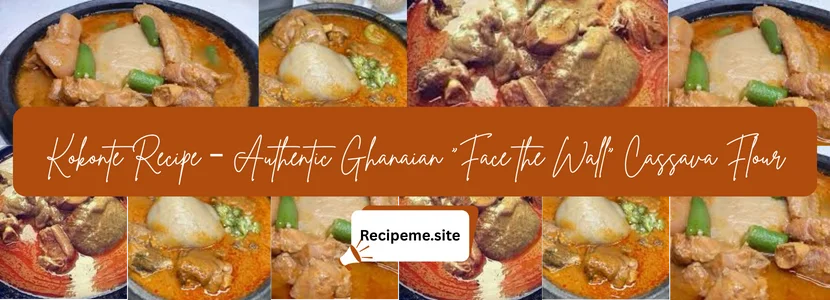
Introduction
Have you ever tasted a dish so simple yet deeply comforting that it instantly reminded you of home? For many Ghanaians, that dish is Kokonte, popularly nicknamed “Face the Wall.”
Made from dried and ground cassava flour, Kokonte is one of Ghana’s most traditional foods. It carries a reputation that is both humble and nostalgic—once considered “poor man’s food,” but now cherished for its rich taste, versatility, and nutritional value.
I remember vividly my first encounter with Kokonte as a child. Served with light soup and fish, it had a hearty, earthy flavor that made me appreciate how Ghanaian cuisine transforms the simplest of ingredients into satisfying meals.
Let’s dive deeper into the story of Kokonte—its history, preparation, and why it continues to hold a special place in Ghanaian hearts.
History of Kokonte
Kokonte has been part of Ghana’s food culture for centuries. It is most popular among the Akan, Ga, and Ewe ethnic groups, though it’s enjoyed nationwide.
The nickname “Face the Wall” has an interesting story. Decades ago, Kokonte was often eaten by low-income families. Out of embarrassment, some people would turn to face the wall while eating it, hiding from others. Over time, the name stuck—but today, Kokonte is eaten proudly by all, regardless of social class.
Did you know? Cassava, the main ingredient, was introduced to West Africa by Portuguese traders in the 16th century and quickly became a staple because of its adaptability to different soils.
Essential Ingredients
Kokonte is simple to prepare, and its ingredients are minimal yet wholesome:
-
Cassava flour (sun-dried, fermented, and ground)
-
Water
-
Salt (optional)
For the soup (pairing options):
-
Light soup (tomato-based with meat or fish)
-
Groundnut soup
-
Palm nut soup
-
Okra stew or soup
Variations of Kokonte
Over time, Kokonte has developed regional and personal variations:
-
Pure cassava Kokonte – the most traditional form.
-
Cassava + yam flour mix – smoother texture.
-
Cassava + maize flour mix – for added flavor.
-
Modern versions – served in restaurants with assorted meats and contemporary garnishes.
Preparation (Step-by-Step Guide)
Step 1: Boil Water
Bring a pot of water to a rolling boil.
Step 2: Add Cassava Flour Gradually
Slowly add cassava flour into the boiling water while stirring continuously with a wooden spatula (banku ‘ta’).
Step 3: Stir into a Smooth Consistency
Keep stirring to prevent lumps. The mixture should become thick and stretchy.
Step 4: Mold and Serve
Once smooth, scoop and mold into round balls. Serve hot with your preferred soup.
Cultural Significance
Kokonte is not just food—it represents resilience and survival. During tough economic times in Ghana, Kokonte sustained families because cassava was readily available and affordable.
Today, it’s enjoyed not only for its affordability but also for its nutritional benefits. Doctors sometimes recommend it for diabetic patients because it has a lower glycemic index compared to polished white rice.
Eating Kokonte also brings families together. It is typically shared in a communal bowl, reinforcing unity and togetherness.
Serving Suggestions
-
Best served hot with light soup, groundnut soup, or palm nut soup.
-
Can be paired with okra stew for a more filling experience.
-
Often enjoyed with smoked fish, goat meat, or cowhide (wele).
-
A chilled glass of water or palm wine complements the meal beautifully.
Types of Kokonte
-
Everyday Kokonte – simple, served with light soup and one protein.
-
Special Occasion Kokonte – paired with rich groundnut or palm nut soup and assorted meats.
-
Health-conscious Kokonte – eaten with lighter vegetable soups, often without oil.
Tips for Making Perfect Kokonte
-
Use finely milled cassava flour for a smoother texture.
-
Add the flour gradually to prevent lumps.
-
Stir consistently—this is the secret to silky Kokonte.
-
Serve immediately; it hardens when left to cool.
Did you know? Kokonte was once unfairly stigmatized, but today many Ghanaians and food enthusiasts abroad embrace it as a gluten-free superfood.
Other Valuable Information
-
Kokonte is gluten-free and suitable for people with celiac disease.
-
It is high in fiber, aiding digestion.
-
Fermented cassava flour contains beneficial probiotics that support gut health.
-
Unlike some starch-heavy foods, Kokonte provides a slow release of energy, making it ideal for sustained activity.
Personal Experience / Journey of Discovery
During a visit to a local chop bar in Accra, I ordered Kokonte almost out of curiosity. The earthy taste combined with a spicy palm nut soup completely changed my perception of the dish.
I realized Kokonte isn’t “poor man’s food” at all—it’s a heritage meal, rich in culture, nutrition, and flavor. Ever since, I’ve encouraged friends—Ghanaians and foreigners alike—to try it. Almost every time, they’re surprised at how satisfying and versatile it is.
A Reflective Closing
Kokonte, the so-called “Face the Wall,” has transformed from a symbol of hardship into a celebrated delicacy that embodies resilience, health, and cultural pride.
Whether you’re Ghanaian reliving childhood memories or a food explorer eager to taste something unique, Kokonte (Cassava Flour) deserves a place at your table. One taste might just make you fall in love with this humble yet powerful dish.
Frequently Asked Questions
1. Why is Kokonte called “Face the Wall”?
The nickname comes from a time when it was stigmatized as food for the poor, leading people to eat it discreetly.
2. Is Kokonte healthy?
Yes! It’s gluten-free, high in fiber, and has a lower glycemic index compared to polished rice, making it suitable for diabetics.
3. What soup goes best with Kokonte?
Traditionally, Kokonte pairs well with light soup, palm nut soup, or groundnut soup.
4. Can Kokonte be stored?
Yes. The cassava flour has a long shelf life if kept dry, but once cooked, Kokonte is best eaten fresh.
5. Is Kokonte only eaten in Ghana?
No. Similar dishes exist in Nigeria (called lafun) and Togo, though preparation methods vary.
6. Can Kokonte be made without cassava?
Some variations use yam or maize flour blends, but authentic Kokonte is made from cassava flour.
